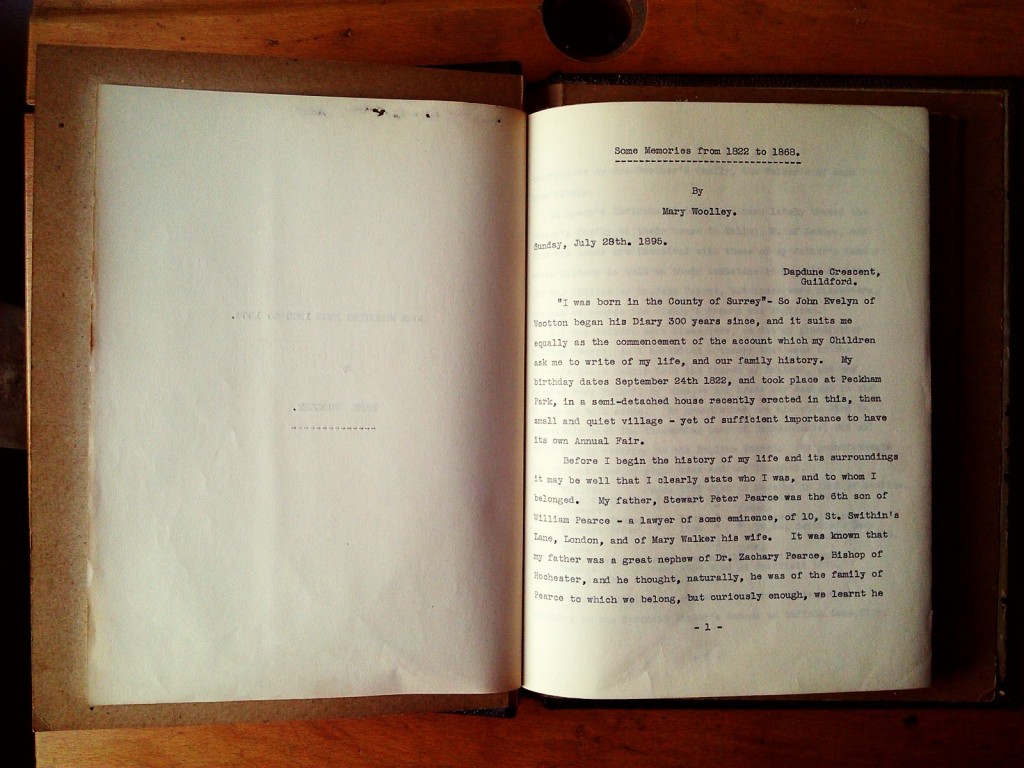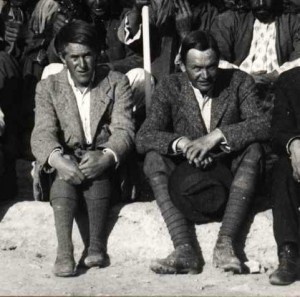Introduction
“Our Stage Coach travelled up from Peckham Rye [to] the Mansion House every morning – returning in the evening. It went by the Old Kent Road to the City, and the guard always carried pistols as there was still a fear of highwaymen attacking them in this very lonely road. Now I imagine, there is not one yard of space uncovered by bricks and mortar.”
I was first lent this unpublished book of Mary Woolley’s memoirs by my cousin, neither of us having any idea who Mary was or whether she was a relative. The first couple of pages are rather dry family background, but then she hits her stride. The local history is fascinating, but also the writing is great – by turns gripping, hilarious and heart-rending. I felt straight away that it deserved a wider audience.
My mother consulted the family tree and told me that Mary was my great great grandmother’s first cousin. She was born Mary Pearce in Peckham (then Surrey, now London) in 1822 and died in Guildford in 1910. Her father was a lawyer, her husband a wine merchant. In 1912 she had 43 descendants living, having had a total of 15 children – 11 named in the family tree and 4 unnamed, presumably died in infancy.
I do not know much more about Mary’s life. The memoir stops frustratingly in the middle of events. She alludes to future misfortunes but we never hear what they are. She was writing for her children’s benefit, and her version of events is slightly official at times, for instance when she writes that her parents objected to her marrying Charles Woolley, but does not tell us why. Sometimes she assumes more knowledge of people and events than we have.
Mary clearly enjoyed a good story and her version of history is quite colourful. Some of her stories are rather second hand and may or may not be accurate, but as a respectable Christian lady, she no doubt believed what she wrote to be true. In some places she puts great literary effort into her writing; in others she just rambles through events as they occurred.
The only research I have done was to locate houses where she lived, so as to add pictures to this website, but the few official records I have seen, such as birth and marriage registers and census information, confirm the main points. At the bottom of each page of this website there is a comments box – do please use this if you would like to share any information.
There is also no guarantee that whoever was responsible for typing the memoirs in the 1910s did not edit them, but it does look as though the typist was quite careful about reproducing spacing, underlines etc. One of Mary’s grandsons was the archaeologist Leonard Woolley, so perhaps the family understood the importance of preserving the past. I have copied the typescript exactly, including anything which looked like a mistake – so please do not email me about spelling mistakes! The only change I have made is to add more paragraph breaks, as some of Mary’s paragraphs ran to several pages, and to divide the memoir into chapters. The chapter headings are my own, as is the title “Highwaymen in Peckham”.
The copy I have is typed and bound, and I spent some time trying to find the original manuscript. I discovered three typed copies in my family, all of which appear to date from around 1914 or after (Southwark Local History Library helped me to date them from the stationer’s label on the bindings), but I drew a blank as to the original. If this still exists, it could be with any one of Mary’s probably numerous direct descendants. The fact that my family, not direct descendants, have several copies suggests quite a few were made and distributed to her relatives.
Researching this project has been fascinating, particularly wandering round London with a camera looking at what has changed in nearly 200 years and what has stayed the same. The site of the stately Hanover House is now shops along Rye Lane in Peckham (pawnbroker, mobile phone shop etc), and if you stand in the car park behind Burger King, you are probably standing in the garden. When I visited St Swithin’s Lane, I was startled to find that the Rothschilds are still in their offices there, but now in a glass skyscraper. I found two of Mary’s homes – 19 Clapton Square and Grove House – still standing, but now divided into flats. It was slightly chilling to realise that I could trace Mary’s husband through the electoral records, but not her as of course she did not have the vote and to discover that when I found her father’s tomb, I had also found that of my own great great great grandfather.
I don’t feel particularly nostalgic for what has gone. I’m quite happy to have the vote and not have died of typhoid as an infant. But it’s fascinating to observe the constant flow of history through the city, and how the past is constantly being pulled down and built over, yet traces remain.
If you would rather read the book on a Kindle you can download the free ebook here.
Jessica Cahill, Crystal Palace, January 2013
Continue to Chapter One: Mary’s family background – St Swithin’s Lane – Peckham – Highwaymen


 Email link
Email link
Thank you so much for putting this on the internet!
Paul Sherer gave me details of your website as we are both researching our ancestors, John sherer and Mary Fayting.
It so good to share information!
Thanks again
Thanks Susan, glad it was helpful. I’ve had a couple of contacts from people in Australia and if you email me via the contact form I may have some more detail to give you.
Hello Jessica, I have been working on my own book for a long time now and have arrived at the point where I would like to integrate some of the information in Mary’s memoir. I would be grateful for any additional information. Regards Paul Sherer. PS I only live down the hill in Beckenham
Hello Paul, I will drop you an email!
Thank you so very much. During family history research, I discovered the Laura Francis (who married Rev. William Peter Pearce) was my husbands great, great, great aunt. It was wonderful to read the story by Mary Woolley. It gives a sociological impression of their lives. I was wondering if anyone has a photo of the Pearce family or any other information. Kind Regards